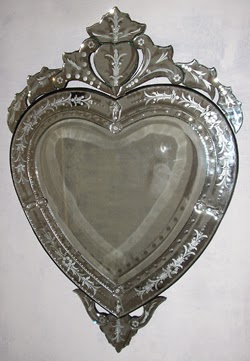
Special Mirror furniture __ The Venetian mirror was born on the tiny Italian island of Murano in Venice in the 15th century. Venetian mirrors were painstakingly produced and creating one was a highly involved process. Upon completion, Venetian mirrors were considered to be masterpieces of art; the beauty of Venetian mirrors surpassed the expectations of what a mirror should be.
Even with the arrival of the 16th century, Venetian mirrors were rarities, and the majority of them were custom made for royalty and nobles with voracious appetites for collecting Venetian mirrors. Because the demand for Venetian mirrors surpassed the supply, it became possible to purchase replicas, or "Venetian style mirrors", from dealers who specialized in upscale, valuable objects. Authentic Venetian mirrors were set in precious frames made of beveled glass borders skillfully adjusted securely into place with metal screws and could only be purchased from Venice, Italy. Thoroughly beautiful, genuine Venetian mirrors were difficult to acquire.
Special Mirror furniture __ Venetian mirrors, the purest mirrors in the world, set the bar very high for other mirror manufacturers. The Venetian mirrors dominated the industry; the authentic Venetian mirrors' popularity wiped out all competitive initiatives from abroad. The quality and the proportion of the Venetian mirrors and their components, combined with the Venetian artists' hundreds of years of crafting experience, made the island of Murano an extremely formidable opponent in the mirror making industry.
Special Mirror furniture __ One reason the Venetian mirrors were considered so elusively beautiful was due to the top secret manufacturing procedures developed by the Murano glass artisans. The Venetian glassmakers perfected the mystical gold dust technique: they inserted gold leaf into the glass prior to the solidification process, leaving the gold leaf imbedded into the mirror's glass. Protected forever, the gold leaf added color and eternal sparkle to the Venetian mirror.
Another highly protected manufacturing secret was the "Lattimo" process. Lattimo is the name given for the translucent milky-white glass. This technique involves the use of lead to color the glass. Over time, Venetian mirror makers perfected the this process and achieved the skills to necessary to manipulate a variety of effects within the glass. When artfully distributed throughout the glass, the Lattimo process breathed new life into the Venetian mirrors. Through the skillful manipulation of the golden dust technique and the lattimo technique together, the creation of such details like artful borders, flowers, and ribbons are possible.
Çontact Us
Address : Jln. Bonang 3 RT 2 RW 2, Joyotakan, Serengan, Surakarta, Jawa Tengah, Indonesia, Indonesia 57157Owner : Prima Warsa BaruPhone : +62 888 6 827 827Email : sales@jagomerahcraft.comFanpage Facebook : jagomerahcraft





